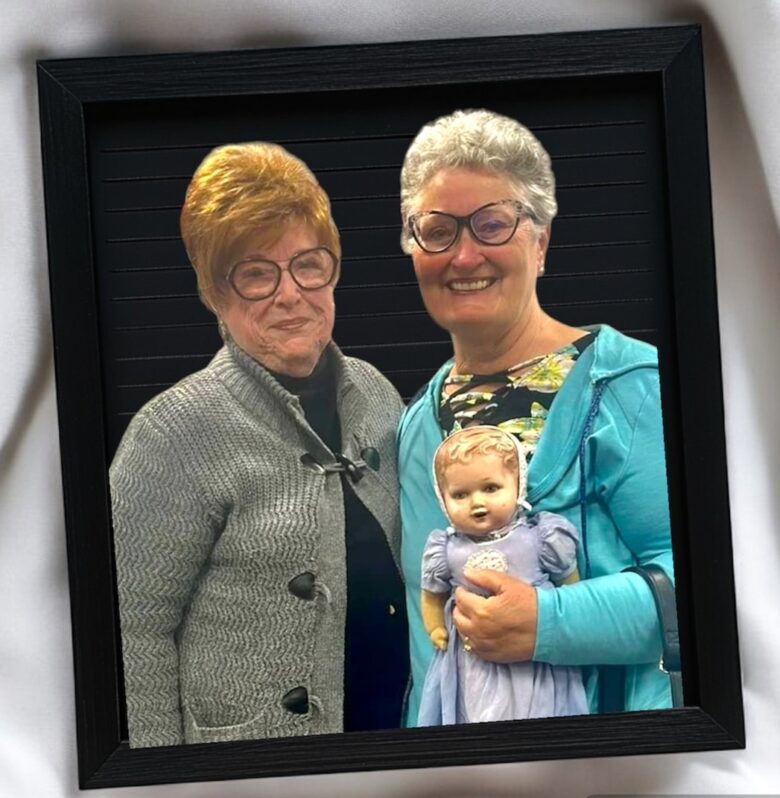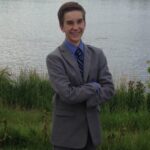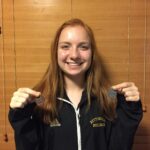What Doesn’t Break You, Makes You
The True Story of Yvonne Aronson
Written and Illustrated by Andrew Ball & Mackenzie Rice
A BOOK by ME - True Stories Written by Kids for Kids
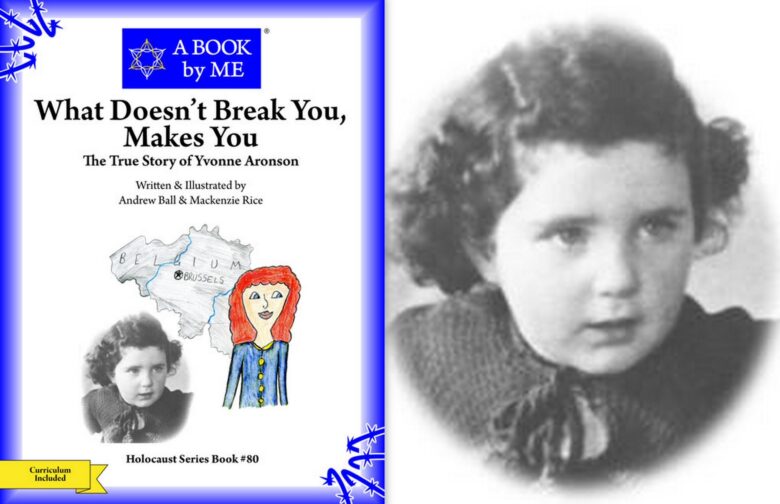
About ten years after her book was published, I heard Yvonne Aronson would be speaking about an hour away from where I live. I was excited to hear her speak and was surprised when she had a doll on stage with her. I don’t believe she mentioned the doll given to her before she went into hiding during the interview with her young author. As we chatted afterward, I mentioned I’d like to add “thought bubbles” introducing the doll and having her share at the bottom of each of the ten pages. Yvonne thought it was a good idea to bring her doll’s perspective added to the story.

I know the importance of teaching emotional intelligence to children to help them recognize their feelings about situations in their own lives. Perhaps Yvonne’s doll comments about her child’s feelings of loneliness and missing her mother may make some readers understand their own feelings and begin to feel less anxious. I’ve read that lessons on emotions can also help them manage their impulses, which can lead to better concentration. We also added a QR code that will take students to a YouTube of Yvonne speaking for the Illinois Holocaust Museum in Skokie, Illinois. Kids will be able to hear her voice for generations to come.

We did not take away anything from the original young author’s work but Yvonne and I both felt that the QR code and introducing her doll and these thought bubbles are very worthwhile. She’s a pretty amazing lady and I’ve really enjoyed working with her on these additions. We are looking forward to her coming to speak to schools in our area sometime soon.
Deb Bowen
Executive Director Understanding Works (501c3 nonprofit organization)
“We wanted to share Yvonne’s story, not just as a book, but as a heartfelt memory. Though Yvonne was very small, she was a brave little girl when she was sent away from her family to be a part of someone else’s. We hope you feel inspired by her story as much as we do and that you will remember it too.”
Andrew Ball & Mackenzie Rice
Authors/Illustrators
- Andrew Ball
- Mackenzie Rice
Yvonne Aronson – Jewish Holocaust Survivor
Yvonne Knopf was born on April 5th, 1939 in Brussels, Belgium. As an adult, Yvonne really feels her journey begins in 1887 when her great-grandparents came from Vienna, Austria to New York City, NY.

Baby Yvonne with her great grandmother Malvina Kohn
They intended to make a new life in America. Their first baby, Yvonne’s grandmother, was born in 1888. Two years later her great-grandmother packed up and took the baby back to Austria. Her husband thought she would come back but she did not so he returned to Europe after a year of waiting for her. This is why her family was in Europe when Hitler rose to power. Now the stage is set for Yvonne’s story.
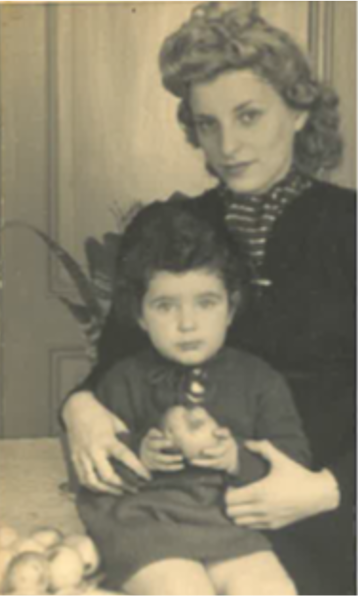
Yvonne with her mom Spring 1941
When Yvonne was a young child, she had blue eyes, freckles and curly, bright red hair. She was loved by her large extended family: her mother, Ilse Breier Knopf; her father, Ladislas Knopf; her great-grandmother, Malvine Kohn; her grandmother, Theresa Liewer; her uncle, Emil Rosenthal; her grandfather, Arthur Breier; her great aunt and uncle, John and Helen Marcus; their children, Lisa and Fred Marcus; and her mother’s sister, Lilly.
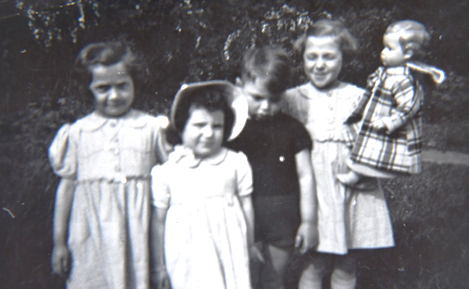
Yvonne in hat with friends Claudine Peter and Lucienne in 1942
In order to escape the Nazis during World War II, Yvonne went into hiding with her mother, her great-aunt, and her great-grandmother. Together, they hid in a convent for six months. After that, Yvonne and her mother moved back to their apartment, where her mother eventually came down with influenza. Because she was sick, the local druggist hid them in his cellar for three months.

Yvonne with toy puppy 1942
In 1942, when Yvonne was only two and a half years old, she was sent to the suburb of Auderghem where she stayed with Jeanne Stevens, a widow, and her son, Charles, who was a mailman. While Yvonne was in Auderghem, her mother stayed in the city to work and her great-aunt and great grandmother continued to hide in the convent. For almost three years, she remained with the widow and her son. To protect her identity, Yvonne was passed off as the widow’s granddaughter. Although she was not allowed to play with any of the other children in the neighborhood for fear of her identity being discovered, she did help tend Jeanne’s husband’s grave and the vegetable garden. Yvonne describes the white and gray-haired widow as having been extremely sweet and kind-hearted to her, as well as protective.
During this time, Yvonne’s father and uncle were sent to a labor camp in Carcassonne, France. Her father was later transferred to Auschwitz, where he perished. Her aunt died in Auschwitz as well, just days after being sent there. Sadly, her father’s death happened just five days before the Soviet army liberated the camp. Her uncle left the labor camp and went to work with the French underground.
Everyone was in danger because of Hitler. It was important for both the hidden child and the one who was hiding her to be very careful and not let Yvonne be seen. It was a very lonely existence for a little girl. Young Yvonne was very grateful for a kind Belgium woman who gave her a doll and a handful of books before she went into hiding. Having something to play with kept her sane. It was a symbol of hope. Emotionally, her doll was important since it served as a companion, a source of emotional strength for little Yvonne. The books she was given were not exactly children’s books. They were chapter books for older readers. However, young Yvonne didn’t have much to do so she taught herself to read using those books. These books are very worn from being read over and over again during the war. Yvonne still has the doll and the books today. The doll goes on the road with her when she speaks about the Holocaust. She stands as a symbol of hope during unimaginable darkness. She, along with the books, provided emotional support and a sense of normalcy.
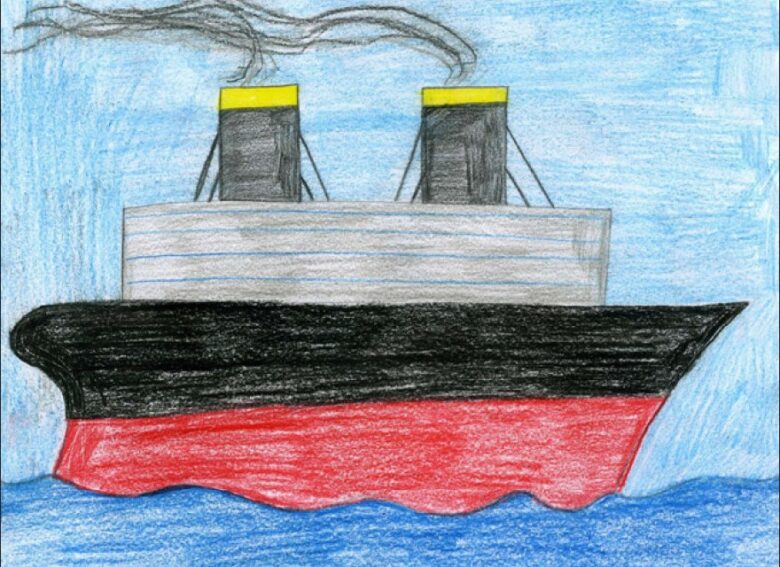
Yvonne finally came out of hiding in 1945. She and her mother, Ilse, immigrated to the United States. They traveled by train from Brussels to Copenhagen, and then went by Yvonne Aronson Jewish Holocaust Survivor ferry to Sweden where a ship awaited them. Yvonne was extremely seasick the whole way to America. She only visited the dining room once. They arrived in New York on March 24, 1947 and spent two days sightseeing. They then headed to Chicago, where Yvonne’s grandmother lived.

Young Yvonne arrived in Chicago and immediately her mother signed her up for grammar school. She didn’t speak English and the children were not kind. Oftentimes war refugee children are mistreated in school. She’d already endured the hardship of war, fleeing their homes and leaving behind everything they once knew. Now she was forced to face the challenges of adapting to a new country and culture. The language barrier did not help at all. Yvonne’s experience of being mistreated by classmates compounded her trauma and has had long lasting negative effects. Today she feels like it’s crucial for schools to create a safe and inclusive environment for refugee children where they feel welcomed, respected and supported. Schools today know it’s important that they do their part in helping these children heal from past traumas. Now young readers learning from this story can understand it better too. They could greet them personally each morning and become friends. Encourage other friends to do the same. These friendships might help them learn English which would help them feel supported, safe and accepted in their new environment.

Yvonne married Howard Aronson in November of 1959. They had three children: Larry, Richard and Lori. She now has five grandchildren: Melissa, Matthew, Molly, Samantha and Colin. Her great-granddaughter, Sophia, was born June 9, 2013. She and Howard are now divorced. Her children became very successful. Larry has his own advertising agency, while Richard is an attorney working in real estate, and Lori is a pediatric anesthesiologist at the Cincinnati Children’s Hospital Medical Center. Yvonne still lives in Glenview, a suburb of Chicago.
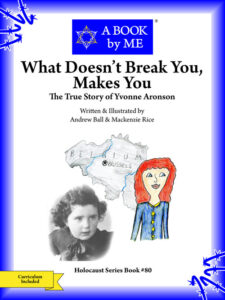 What Doesn’t Break You, Makes You
What Doesn’t Break You, Makes You
Yvonne hid with her mother and a few other relatives in a convent. Later, when Yvonne’s mother became ill, they moved to the cellar of a drugstore. She eventually lived on her own with a non-Jewish family, hiding her identity.
Link to purchase books from the Holocaust series >
A BOOK by ME, a book series developed by Deb Bowen, empowers students to preserve history by telling the story of unsung heroes in our communities. For the young participants, it’s a guided cross-curricular project that gathers stories of people who do amazing things but have received little or no recognition. Students learn how to publish a picture book that is a primary source document with photographs and a biography.
Since 2003, Deb Bowen has been arranging meetings between students and individuals from the WWII generation. This intergenerational storytelling results in unique storybooks written and illustrated by kids for kids in the A BOOK by ME series. More about Deb Bowen >

